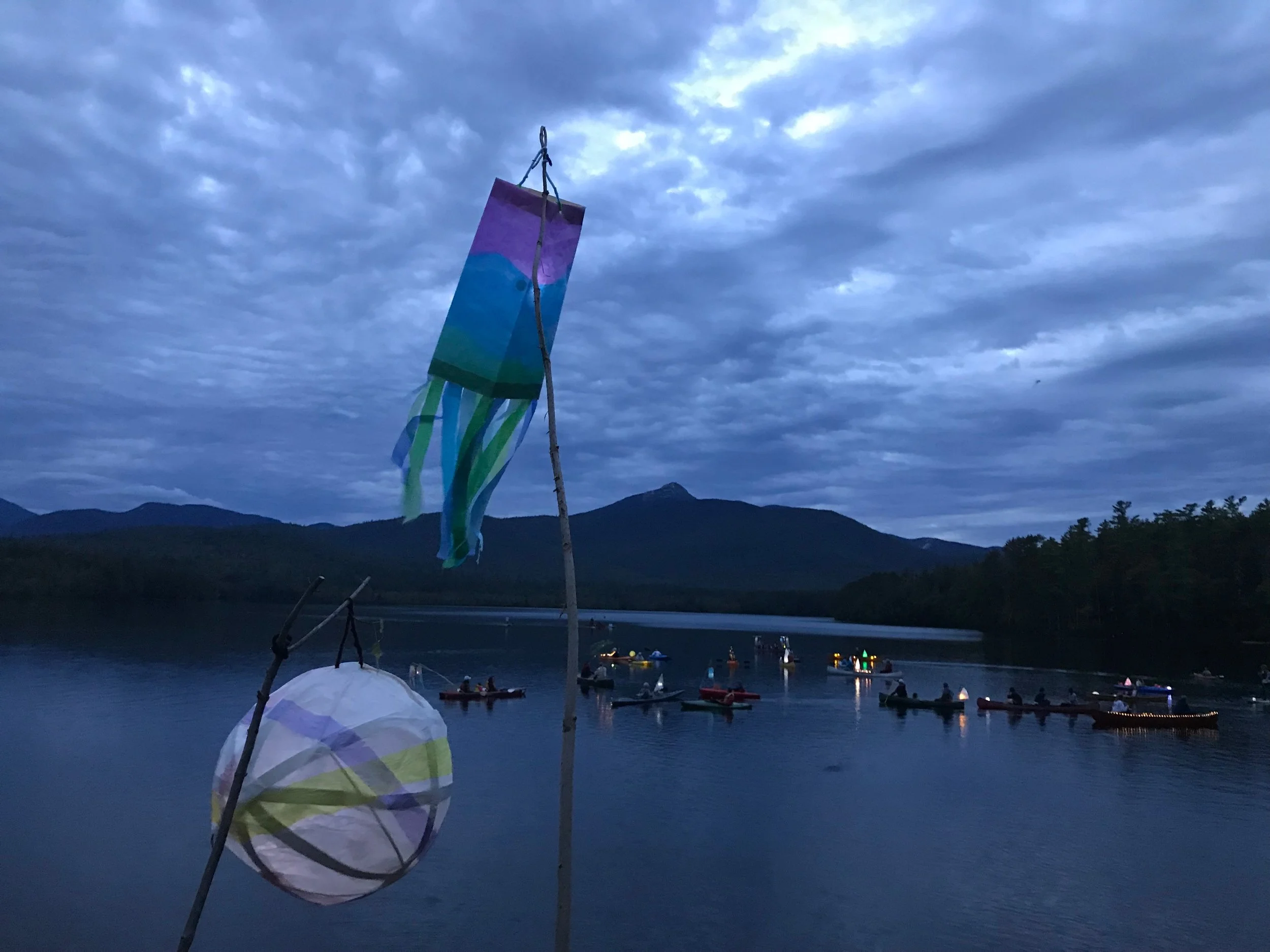The “subnivean layer” is the insulated space between the snow cover and the frozen ground beneath. Many animals take advantage of this thin layer of warmer air and space to continue with daily activities.
Nature Notes: Snowfleas!
2019 Fall Newsletter
Download a copy of our 2019 fall newsletter here. This issue is all about stewardship! And a few other things—the phantom crane fly, thank yous to dedicated board members as they retire, Chocorua Lake Basin project updates, and more.
Water-Loving Loons
Nature Notes: Winter Nesting
Nature Notes: Wolf Pines
A wolf pine is a large multi-trunked pine with spreading branches. You can often find them along old stone walls in the woods, or around the edges of fields. They look pretty gnarly and aren’t usually considered “valuable” from a timber perspective. But from a wildlife perspective though they can be a bonanza!
Nature Notes: Snappers & Wooly Beasts!
A Cold Winter
Wildlife Sightings from Summer
by Harriet Hofheinz
It has been a quiet summer and early fall from the point of view of Chocorua Basin wildlife. This is not unusual as animals make themselves scarce and away from humans during the high season of our activity. But there have been a few exceptions. Bears have been spotted in various places, mostly on the prowl for food. One young three year old showed up at my house earlier in the summer interested in my bird feeder. Without much pause, he came right up to the house and knocked on my bedroom window. He hung around often waiting for me to leave before helping himself. I finally took the feeder in and he moved on and was spotted around the basin by several folks. He may have even crossed over Route 16 as a young bear was observed on Washington Hill Road. Additionally, Don Johnson had a Mom with four cubs visiting his back yard from time to time during the summer. That’s a lot of young ones to tend to. If there is not enough food, sometimes a mother bear will dispatch the youngest, chase it away to fend for itself, so she can feed the stronger cubs; cruel, but necessary for the survival of the remaining cubs.
On Columbus Day Rt. 16 trash pickup, Melissa and Troy Emerson found one dead raccoon and one dead barred owl on their watch (see photo). Probably both animals were victims of a deadly car encounter on Rt. 16. Bald eagles and ospreys have been sighted particularly during the later part of the summer. Those sightings are a testament to the extraordinary recovery of these two species after poisonous DDT was found to be the deadly culprit of near extinction of several species of birds in the 50's and early 60's. Those species such as eagles, ospreys, peregrine falcons, loons and many others that breed in NH or the northeast have all rebounded, some better than others. The eagles particularly are doing well, establishing many nesting sites now in NH. That’s the good news. The bad news is that many other land birds (neo-tropical birds) that migrate to nest in New England are not doing so well. For instance, our breeding thrush survey now in its 22nd year, shows steep declines in one of our favorite songsters, the wood thrush. Not as precipitous as the wood thrush, our hermit and veery populations are also showing decline. Our thrush survey is unfortunately indicative of the decline in other songsters who breed in the basin but winter in the south.
Feline wildlife sightings are rare, exciting, and sometimes confusing. What is that wild cat? In the Basin, it's most likely a bobcat, which is enjoying a population rebound in response to a hunting ban enacted in 1989. The ban has been so successful, in fact, that hunting may be allowed again. The organization Voices of Wildlife in New Hampshire is following the issue and collecting signatures for a petition to keep the bobcat protected. For up to date information on the hunting ban, go to their website.
Both the bobcat and the Canadian lynx belong to the Lynx genus, which adds to the confusion. The Canadian lynx is a snow-loving cat that's more populous in northern climates, but is occasionally seen in New Hampshire. If you're lucky enough to get a good look at a cat in the wild, look for these traits:
A bobcat’s stubby tail tip is black in the front and white in the back, so when running away, the white shows clearly. The lynx’s tail tip is all black.
A bobcat’s tracks are catlike running straight. A lynx’s paw print is longer and wider than a bobcat, more like a snowshoe hare (its common prey), and its hide legs are notably longer than its front legs, enabling it to run faster in the snow.
The lynx has a long, mottles grayish coat and pointed ears that are well covered with fur whereas the bobcat is brownish in color, with smaller pointed ears with less fur.
Banner: Betsy Whitman Memishian
Wildlife Sightings From This Past Winter
Three eagles, two mature and one immature, stationed themselves at the head of the Lake eating any leftovers the ice fisherman threw on the ice, as well as a deer carcass. We’ll see if they stay around for their breeding and nesting season. The presence of these carnivorous predators would certainly be upsetting to our beloved loons.
It was a tough winter for humans and wildlife alike! How do animals adapt to the deep snow and cold? Evidence of the deer “yarding up” under hemlocks to avoid the deep snow was abundant, usually on south facing hillsides. This technique of holding steady can go on for days until better conditions prevail. Rough grouse use a similar technique to bed down in powder snow for the duration of a storm, perhaps for several days, and only when disturbed by another critter do they erupt from the depths of the powder, severely startling the trespasser. Their frozen pellets are left under the snow as evidence.
Opossum at the feeder. Photo: Dave Farley
A hungry opossum appeared late in February at Dave Farley’s feeder. This solitary and nomadic critter is more suited to the warmer regions of the southern United States, with a strong immunity to snake venom and a coat of awn hair only, like all marsupials. He is not well outfitted for the winter we had this year, and his feet and his tail can become badly frostbitten, causing a lot of pain.
Otters can navigate easily across the snow by sliding on their bellies, and their telltale track-‐slides have been spotted coming from the Smith’s drive, down to Walley Brook, on to the brook behind the Hallowell house, on to the pond near the Helm’s drive, and continuing along the shore to the north end of the lake!
The resident porcupine continues to travel between its den under the Smith’s front steps to the Hofheinz woodpile; in both places, he leaves his droppings neatly piled outside.
A downy woodpecker and a tufted titmouse at the feeder. Photo: Harriet Hofheinz
Bird feeders are a godsend to our feathered friends in the winter, and some birds don’t survive without them. But the hardy do, as they have for a long time before we were around. John Watkins has seen pileated, hairy, downy and red bellied woodpeckers, as well as the usual nuthatches, chickadees, purple finches, blue jays etc. In addition, more northern species such as the redpoll, crossbill, and tree sparrow are coming to his feeder. Barred owls on Groundhog Day began their mating rituals with lots of characteristic calls to one another. They seemed unfazed by the weather.
Like clockwork, our resident loons happily returned soon after the ice was out to investigate and prepare their nest. With no identifying leg bands, it’s impossible to be sure, but it is presumed that this is the same pair of loons from last year.
Speaking of loons, John Conroy reported that the Loon Center rescued three 1st-year loons from the frozen coast in January and February. Two did not survive, but the one found in the parking lot, was released after it recuperated at the Center.
Banner: Ed Parsons










